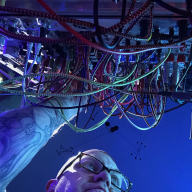Reflections on Ambiguity Groove
Table of Contents
Cross-cutting cleavages of terminology between art and science show up daily my work in socio-technical systems. It feels a little bit natural that we lean on familiar constructs to guide us into new ones. As I’m prepping to talk next month at DevWeek 2022, I cannot help but look back at last year’s conference sharing my perspectives on navigating the difficult headwaters of categories through stories of metaphor.
Some of the more difficult concepts in philosophy and technology creeped their way into my understanding through metaphor. However, when things get hairy, layers of abstraction - like metaphors - can become dimensions of ambiguity. They can divide our shared understanding and create unnecessary obstacles in coordination.
I want people in operations like me to understand that it is OK to allow things to be blurry at the edges. More precise measuring and automating may ignore surprises that appear outside of the boundaries where we know to measure and automate in the first place, so we should allow ourselves to see that the boundaries are not well defined. Ambiguity cannot be masked by strict models and dogmatic language.
Orchestration#
Here sits a category of work in two strongly connected fields that many humans straddle: music and computers. Categories like this one are messy, heavy with the experiences of individual minds having built the concepts through lower level metaphors internalized throughout a lifetime of interacting with the physical world (see George Lakoff and embodied cognition if you’re curious). Because experience and context have a great deal to do with the way we understand a concept, you will get wildly different answers for an understanding of the word orchestration.
Looking at my bookshelf, Samuel Adler’s The Study of Orchestration is inches away from the O’Reilly Seeking SRE compilation. They contain wildly different constructs of orchestration. In music, we think of it as the process of interpreting music by breaking it down into chosen parts arranged for a collective to perform. The outcome leads to being the recombined piece of music. In tech products and marketing, the term is overloaded with multiple meanings ranging from configuration management and image building to scheduling and resource allocation. It spins my head every time I hear the word used a different way, it either means “ALL OF IT” or it means something very specific.
The place this metaphor finally trips up for me is that orchestration is necessarily a model. It is quite literally the score. And operating things pulls us away from the model. Once we’re in the performance we’re talking about conductors, players, improvisers, calls and responses. Scores dissolve, they were only ever guides.
Real-time systems cannot be models, the orchestration cannot be the orchestra. So when I hear phrases like “orchestration tooling” that makes me feel as if way too much emphasis is being placed on the model in the tech industry, instead of how to build for adaptation by the players.
Language is a Virus#
And every reader probably has their own idea of what orchestration means in their context. As I recently learned from the hotdog comic, language is use. Instead of decrying someone stating they have found a root cause, appreciate their context, don’t correct them. There is no such thing as a cause but we need our language to communicate and coordinate, so understanding intention is much more important.
I recently responded to a tweet about the inexistence of “incidents” and “causes”:
I think of an ‘incident’ as merely an ictus of the rhythms in our data and systems made visible. Like music, the containing structure is belied by its articulators of form - what we might call ‘causes’ when directly observed. An ictus itself, like an incident, signifies nothing.
Ambiguity is a fluctuating continuous reshaping moment by moment as a diverse chaotic spectrum of change. We face it in networked software systems a great deal. I often find myself wondering how to extract the usefulness out of something as common as a word that goes misused and misunderstood.
Do words even matter? William S Burroughs said “language is a virus”, and I have seen it in the challenges to a word’s progeny, pecking at it with post-truths and cherry-picking definitions for our own purposes. Then we wrongly assume others understand the category as we do, or we reject the term over our own variation, leading to more ambiguity.
Diversity in Adaptation#
Who doesn’t fondly recall our last incident war room and its postmortem as much as those early product cave sessions with the occasional spike to ensure we have the pillars of observability as table stakes and not lingering technical debt? Was there a root cause at all or were we not robust enough? Or wait, is it that we weren’t reliable enough? Or were we not resilient enough?
Disciplines borrow ideas and words from each other all the time in strikingly diverse ways. Humans find it natural to exploit shared metaphors to gain pathways to understanding, because somewhere deep there is an embedded pattern that matches or is itching to be expanded. So as an adaptive socio-technical worker I embrace ambiguity. I treat ambiguous situations as the perfect opportunity to open new dimensions, to discover the unknown instead of fear it.
At the core of the 2021 talk is a phrase from Diversity and Complexity (Scott Page, 2010, Princeton University Press) to describe core attributes of a complex system:
"Diverse, interdependent, networked entities that can adapt"
It is through our ability to adapt that we are able to survive, bringing with it the incredible ingenuity of the human mind. For the talk, I decided a good way to show a few paths where I navigated the space of all these words was when I recognized the fundamental surprise behind resilience in something as simple as the groove of a vinyl record being recorded on X-Ray film in Soviet Russia.
But is it Instinct?#
It is through the construct of our mind that we are able to stack metaphors in the first place and have interconnected thought. The things we automatically apply through practice and experience become so salient that we often refer to them as instinct instead of learned intuition.
Some matters of instinct in a socio-technical system feel more like:
- What will always be true is that what to do will not always be clear.
- We only know how Reliable the system is by its history.
- Robustness comes with tradeoffs.
- Hindsight as a reflex is useless.
Groups may try to show how they “build Resilience” but it is clear to me that one cannot build something that emerges.
Nevertheless, you can build the circumstances in which Resilience may appear, as a musical group does when they practice improvisation together, or when an organization supports regular sessions dedicated to common grounding. My talk for DevWeek 2022 is titled Resilience Thrives in the Practice of Practice, about how to build group intuition so that we understand our adaptive capacities and be comfortable together as pieces of the system.
We may start from instinct to survive, but we learn and build intuition to live.

